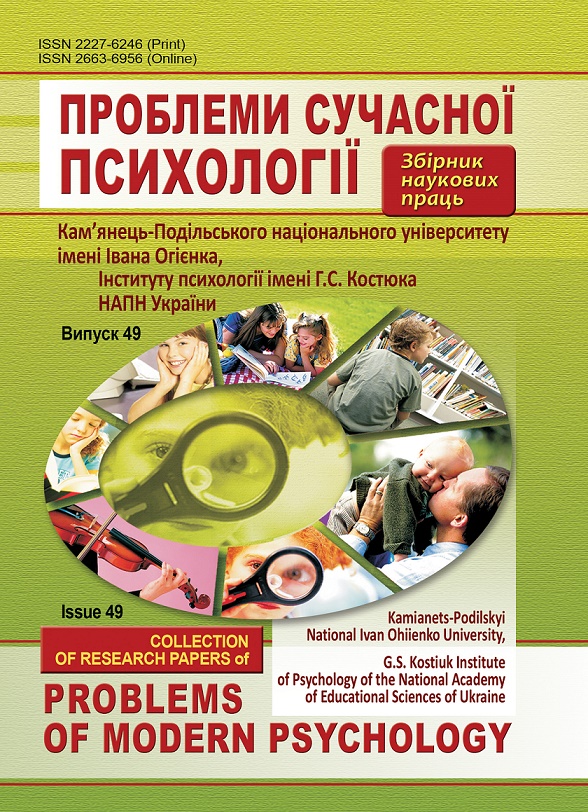Psychological Aspects of Comics as the Paraliterary Genres
DOI:
https://doi.org/10.32626/2227-6246.2020-49.106-130Keywords:
comics, psychological aspects, paraliterary genres, combining words and images, temporal transitions, virtually unlimited possibilities, message of a scene, subject-to-subject change, visual interpretive skills, verbal interpretive skills.Abstract
The purpose of our article is: to define the main narratological devices and inventions made by Alan Moore and represented in his milestone novel, Watchmen, which may help us to define psychological aspects of comics as the paraliterary genres.
Methods of the research. As for general scientific methods the following ones are applied: the method of induction, deduction, analysis and synthesis, comparative and descriptive methods and explanatory ones.
The results of the research. The psychological characteristic of comics is the fact they do not have an omniscient narrator in the same way that traditional literature does, there isn’t all-knowing all-seeing power behind the action. Comics use focalizers and narrators and point-of-view shots, which are an integral part of the narration of the graphic novel. One could argue that the omniscience of narration takes place in the visual depiction of the narrative when no focalization takes place and the images merely illustrate the actions from a clearly outside point of view. The reader is «pulled in» to the story, and only after a visible break in the narrative structure the reader once again becomes aware of the narrative structure and the discourse it applies and consequently uses different interpretational tools.
Conclusions. According to the results of our research we’ve maintained psychological aspects of comics as the paraliterary genres. The visual meaning of comics as the paraliterary genres is verbalized and narrativized through the language. Comics communicate in a «language» that relies on a visual experience common both to creator and the audience. The format of the comic book presents a montage of both the word and the image, and the reader is thus required to exercise both visual and verbal interpretive skills. The regimens of art (e. g. perspective, symmetry, brush stroke) and the regimens of literature (e. g. Grammar, plot, syntax) become superimposed upon each other.
Comic book experts still continue to stress the unique nature of reading abilities are required by comics, and the union of the word and the image has become even more centralized in contemporary studies of comics. Comics are seen as a language, even though the Grammar of this language is far from the completeness of the Grammar rules of a written language.
The single panel has traditionally been seen as the basic component of comic book narratives, and the action traditionally takes place from panel to panel. These transitions can be temporal, which include a clear transition and usually very little closure; this is the most common one in comic book narration. The transition can also be spatial, which consists of subject-to-subject change, where the panel shifts from one subject to another while still remaining in the same scene or idea. We have to stress that at this point, a degree of reader involvement is necessary to render these transitions meaningful. This type of transition is often very powerful, because it enables the writer to leave out dramatic actions deliberately, thereby increasing the level of suspense.
Also we distinguish various ways of combining words and images, from word specific (the pictures simply illustrate what the captions might say) to interdependent where only together do the words and pictures actually convey the message of a scene. Still, we’ll admit that the possibilities are virtually unlimited.
References
Гончарук Н., Онуфрієва Л. Психологічний аналіз рівнів побудови кому¬нікативних дій. Psycholinguistics. Психолінгвістика. Психолинг¬ вистика. 2018. Вип. 24 (1). С. 97–117. DOI 10.31470/2309-1797- 2018-24-1-97-117.
Chatman, S. (1978). Story and Discourse. Narrative Structure in Fiction and Film. New York : Cornell University Press. 98 p.
Genette, G. (1980). Narrative Discourse. An Essay in Method. J. E. Lewin (Trans.). New York : Cornell University Press. 136 p.
Joyce, J. (1999). A Portrait of the Artist as a Young Man. URL : https:// www.sparknotes.com/lit/portraitartist/.
McCloud, S. (1993). Understanding Comics. The Invisible Art. New York : HarperCollins. 220 p.
Moore, A., & Gibbons, D. (1987). Watchmen. London : Titan Books (DC Comics). 108 p.
Mykhalchuk, N. O., & Ivashkevych, E. E. (2016). Psycholinguistic characteristics of visual narrative discourse. Психологія: реальність і перспективи: Зб. наук. праць. Рівне : РДГУ. Вип. 7. С. 146–149.
Honcharuk, N., & Onufriieva, L. (2018). Communicative needs in the structure of the intercourse process. Fundamental and Applied Re¬searches in Practice of Leading Scientific Schools, 27 (3), 111–116. URL : https://farplss.org/index.php/journal/article/view/373.
Downloads
Published
How to Cite
Issue
Section
License
Copyright
The Editorial Board has the full right to publish original scientific papers containing results of theoretical and experimental research works which are not currently subject to review for publication in other scientific editions. The Author shall transfer to the editorial board of the Collection the right to spread the electronic version of the paper, as well as the electronic version of the paper translated into English (for papers originally submitted in Ukrainian and Russian) by all kinds of electronic means (placement at the official website of the Collection, electronic databases, repositories etc).
The Author of an article reserves the right to use materials of the paper, without approval with the editorial board and the founders of this Collection: a) partially or fully, for educational purposes; b) for writing own dissertation papers; c) for preparation of abstracts, conference reports and presentations.
The Author of an article can place electronic copies of the paper (including the final electronic version downloaded from the official website of the Collection) at:
- personal web resources of all Authors (websites, webpages, blogs etc.);
- web resources of the institutions where the Authors are employed (including electronic institutional repositories);
- non-profit public access web resources (for example, arXiv.org).
But in all cases, it is obligatory to have a bibliographic reference to the paper, or a hyperlink to its electronic copy placed at the official website of this Collection.






